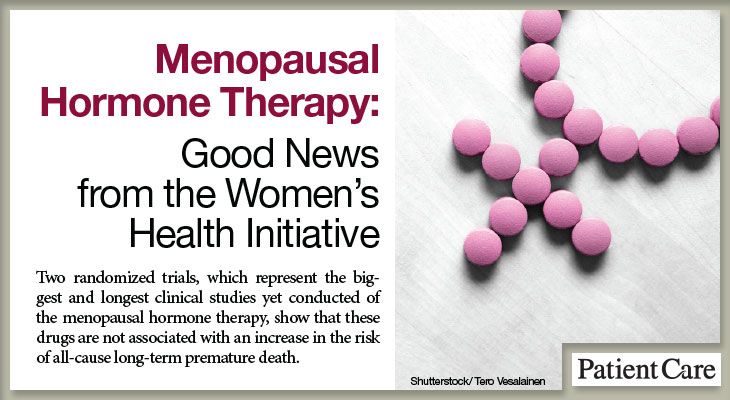© 2025 MJH Life Sciences™ , Patient Care Online – Primary Care News and Clinical Resources. All rights reserved.
Medicine in the Headlines: When Your Patients Ask
HRT, tattoos, insurers exacerbating the opioid epidemic, prolonged sitting, plus a new COPD drug: here's a recap of 5 of the week's key news reports.

HRT. . . tattoos . . . insurers exacerbating the opioid epidemic. . . a new COPD drug . . and prolonged sitting: here's the news about these 5 subjects this week.

Manson and colleagues from the Women's Health Initiative write in JAMA that "Among postmenopausal women who participated in 2 parallel randomized trials of estrogen plus progestin and estrogen alone, all-cause mortality rates for the overall cohort in the pooled trials were not significantly different for the hormone therapy groups vs the placebo groups (27.1% vs 27.6%; hazard ratio, 0.99 [95% CI, 0.94-1.03])." Bottom line: "Among postmenopausal women, hormone therapy with conjugated equine estrogens (0.625 mg/d) plus medroxyprogesterone acetate (2.5 mg/d) for a median of 5.6 years or with CEE alone for a median of 7.2 years was not associated with risk of all-cause, cardiovascular, or cancer mortality during a cumulative follow-up of 18 years." Manson JE, et al, for the WHI Investigators. Menopausal hormone therapy and long-term all-cause and cause-specific mortality: The Women’s Health Initiative randomized trials. JAMA. 2017;318:927-938. Link to Source.

Tattoos, multiple piercings, and scarification have become commonplace among adolescents and young adults. Is there a link between link tattooing and high risk behaviors? How best to ensure safety? What are the potential complications, and what is the complication rate? You can get answers to these and other questions your patients may ask you from the American Academy of Pediatrics, which has just released its first report on the subject. Breuner CC, Levine DA, for the American Academy of Pediatrics' Committee on Adolescence. Adolescent and Young Adult Tattooing, Piercing, and Scarification. September 2017. Link to Source.

ProPublica and The New York Times reviewed Medicare prescription drug plans for 35.7 million people and found that only a third had access to transdermal buprenorphine, which carries a lower risk of overdose than morphine. And among those whose plan covered lidocaine patches, which cost more than other generic pain medications, prior approval was required. Almost all plans covered common opioids, and few required prior approval. For example, United Health Care, the largest health insurer in the US, includes morphine on its lowest-cost tier: no prior approval is required. Buprenorphine (Butrans) is frequently excluded. Pregabalin (Lyrica), a GABA analogue, is on the insurer's most expensive tier, requiring patients to try other drugs first. Thomas K, Ornstein C. Amid opioid crisis, insurers restrict pricey, less addictive painkillers. New York Times September 17, 2017. Link to Source.

The FDA has approved Trelegy Ellipta (fluticasone furoate, umeclidinium and vilanterol) for use in COPD. The drug is an inhaled corticosteroid, long-acting muscarinic antagonist (LAMA) and long-acting beta2-adrenergic agonist (LABA) combination. It is for long-term, once-daily, maintenance Rx for patients with COPD, including chronic bronchitis and/or emphysema, who are on a fixed-dose combination of fluticasone furoate and vilanterol for airflow obstruction and reducing exacerbations in whom additional treatment of airflow obstruction is desired or for patients already receiving umeclidinium and a fixed-dose combination of fluticasone furoate and vilanterol. The medication is not indicated for relief of acute bronchospasm or for asthma. The drug is the first once-daily product approved in the US that combines three active molecules in a single inhaler for the maintenance treatment of appropriate patients with COPD. The FDA-approved strength is FF/UMEC/VI 100/62.5/25 mcg. Approved on September 18, 2017, the drug will be available in the US shortly. Link to Source.

Multiple studies have shown that sitting for long periods is bad for your health. The authors of a new study from the Annals of Internal Medicine have examined for the first time whether the manner in which sitting time is accrued – in short or long bouts -- has prognostic significance. Diaz and colleagues measured sedentary time in 7985 adults 45 years or older, 340 of whom died over a median follow-up of 4 years. Those with high sedentary time (≥12.5 h/d) and high bout duration (≥10 min/bout) had the greatest risk for death. Physical activity guidelines should target reducing and interrupting sedentary time, suggest the authors. Diaz KM, et al. Patterns of sedentary behavior and mortality in U.S. middle-aged and older adults: A national cohort study. Ann Intern Med. Sept 12, 2017. Link to Source.
Here's a brief look at 5 medical reports your patients may have heard about this week, and references to the original sources if you want more detail.


